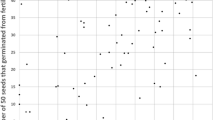Summary
The proportion of the Scottish potato area planted to cultivars such as Maris Piper and Désirée, which can produce large numbers of berries, increased markedly during the 1970s. Such cultivars may add large quantities of true potato seed (TPS) to the soil and create serious weed problems. TPS can survive in the soil through a 7-year potato rotation, whilst tubers from seedlings add to the traditional groundkeeper problem. The implications of TPS as weeds of seed potato rotations are discussed in relation to data presented on seed production and survival and on tuber production by seedlings in the field under Scottish conditions. Seedlings may also present problems as ‘rogues’ in fields where TPS selected lines are grown.
Zusammenfassung
Der Anteil der schottischen Kartoffelfläche, der mit Sorten wie Maris Piper und Désirée bestellt ist, die grosse Zahlen an Beeren produzieren können, stieg seit 1970 deutlich an (Tab. 1). Solche Sorten können dem Boden grosse Mengen an Kartoffelsamen (TPS) zuführen (Tab. 2) und ernste Unkrautprobleme schaffen. TPS kann im Boden eine siebenjährige Kartoffelzuchtfolge überleben (Tab. 3), während die Knollen der Sämlinge zum traditionellen Problem der Durchwuchskartoffeln beitragen (Abb. 1). Die Einflüsse von TPS als Unkraut in Kartoffelfruchtfolgen werden in Bezug auf Daten über Samenproduktion und Überleben und über Knollenbildung durch Sämlinge im Feld unter schottischen Bedingungen diskutiert. Verbesserungen der Erntetechniken können die Populationen der Durchwuchskartoffeln verringern, aber Sämlinge können in jedem Teil der Fruchtfolge erscheinen und die Population der Durchwuchskartoffeln auffüllen solange lebensfähige Samen im Boden vorhanden sind. Die Sämlinge können Probleme schaffen als ‘unerwünschte Pflanzen’ in Pflanzkartoffelbeständen oder in Feldern, auf denen ausgewählte TPS-Linien wachsen.
Résumé
En Ecosse, les surfaces de pommes de terre plantées avec des variétés produisant un nombre de baies important, telles que Maris-Piper et Désirée, ont nettement augmenté au cours des années 70 (tableau 1). Ces variétés peuvent apporter des quantités importantes de semences vraies dans le sol (tableau 2) et créer de sérieux problèmes d'adventices. Les semences de pommes de terre peuvent survivre dans le sol avec cette culture tous les 7 ans dans la rotation (tableau 3) alors que les tubercules issus de semences ajoutent un problème en plus à celui traditionnel des repousses (fig. 1). En Ecosse, les conséquences des semences de pommes de terre, en temps que mauvaises herbes dans une rotation de plants, sont analysées à partir de chiffres indiquant la production et la survie de semences et la production de tubercules dans le champ issus de semences.
Les améliorations apportées à l'arrachage peuvent réduire les populations traditionnelles de repousses mais des plantules issues de semences peuvent apparaître dans toute culture de la rotation et rétablir ainsi une population de repousses aussi longtemps que des semences viables demeurent dans le sol. Les plantes issues de semences peuvent elles-mêmes présenter un problème au niveau de l'épuration dans les cultures de plants ou dans les champs de sélection de lignées de semences vraies.
Similar content being viewed by others
References
Accatino, P., 1980. Agronomic management in the utilisation of true potato seed: preliminary results. In: Report of the Planning Conference on the production of potatoes from true seed. Centro International de la Papa, Lima, Peru, p. 61–99.
Anonymous, 1955. Potato Statistics Bulletin. Potato Marketing Board, London, 8 pp.
Anonymous, 1960. Potato Statistics Bulletin. Potato Marketing Board, London, 8 pp.
Anonymous, 1965. Potato Statistics Bulletin. Potato Marketing Board, London, 8 pp.
Anonymous, 1971. Potato Statistics Bulletin. Potato Marketing Board, London, 7 pp.
Anonymous, 1975. Potato Statistics Bulletin. Potato Marketing Board, London, 8 pp.
Anonymous, 1980. Potato Statistics for 1980/81.Techical Note No 41. The Scottish Agricultural Colleges, 19 pp.
Anonymous, 1981. Classified list of potato varieties 1980/81. National Institute of Agricultural Botany, Cambridge, 11 pp.
Barker, W. G. & G. R. Johnston, 1980. The longevity of seeds of the common potato,Solanum tuberosum.American Potato Journal 57: 601–607.
Bedi, A. S., P. Smale & D. Burrows, 1980. Experimental potato production in New Zealand from true seed. In: Report of the Planning Conference on the production of potatoes from true seed. Centro International de la Papa Lima, peru, p. 100–116.
Kunkel, R., 1980. Physiological and agronomic constraints in the use of botanical potato seed in commercial potato production. In: Report of the Planning Conference on the production of potatoes from true seed. Centro International de la Papa, Lima, Peru, p. 29–35.
Lawson, H. M. & J. S. Wiseman, 1981. Weed control in crop rotations: volunteer crops.Report of the Scottish Horticultural Research Institute for 1980, p. 43.
Lutman, P. J. W., 1977. Investigations into some aspects of the biology of potatoes as weeds.Weed Research 17: 123–132.
Ross, R. W., 1969. Seed dormancy and longevity inSolanum spp.American Potato Journal 46: 438 (abstract).
Stephens, R. J., 1982. Theory and practice of weed control. Macmillan, London, 215 pp.
Upadhya, M. D., 1980. Potential for potato production from true seed under developing country conditions. In: Report of the Planning Conference on the production of potatoes from true seed. Centro International de la Papa, Lima, Peru, p. 12–20.
Author information
Authors and Affiliations
Rights and permissions
About this article
Cite this article
Lawson, H.M. True potato seeds as arable weeds. Potato Res 26, 237–246 (1983). https://doi.org/10.1007/BF02357120
Accepted:
Issue Date:
DOI: https://doi.org/10.1007/BF02357120




